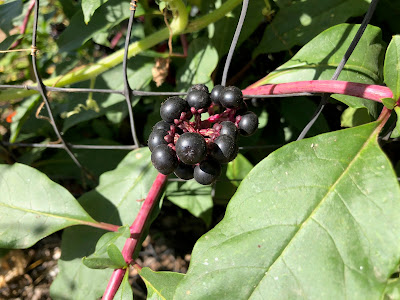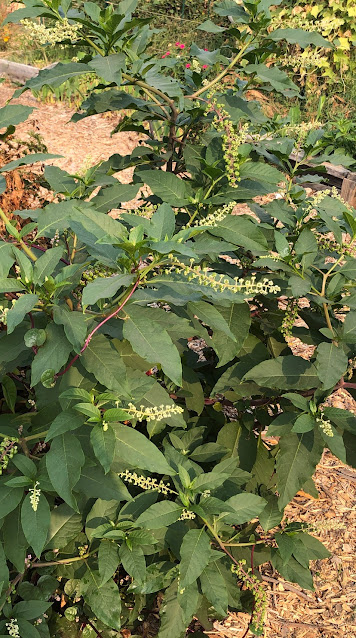
Beware: Pokeweed berries are toxic
Ghosts, haunted houses, bats and other scary images are in season. But do you know what really makes me shudder? Seeing ripe pokeweed berries at child height.

|
|
Usually pokeweed berries grow in grapelike clusters, but
sometimes they appear in clumps like this.
|
American pokeweed ( Phytolacca americana ) is an invasive plant with a long history. It's a native of eastern and southeastern states that has spread over the years to parts of California, including the Central Valley, according to the UC Integrated Pest Management program, which just last week updated its public information page on pokeweed.
"Pokeweed is found in riparian areas, oak woodlands, forest edges, fence rows, forest openings, pastures, under power lines, disturbed areas, vineyards, orchards, cultivated fields, parks, and ornamental landscape," the IPM pokeweed page notes. You'll notice that a lot of those sites are hangouts for birds.
The plant has some uses: The berries' juice make wonderful dye, apparently, and also has been used for ink. Historically the leaves were considered edible; one of its alternate names is "poke salad."
But UC IPM is unequivocal in its warning against consuming any part of this plant:
"Although sometimes eaten, the entire plant is poisonous and should be considered with extreme caution. The leaves and stems of young pokeweed plants can be ingested only after repeated blanching; without proper preparation, pokeweed can cause a variety of symptoms, including death in rare cases."

|
|
A single pokeweed plant can produce up to 7,000
seeds annually.
|
Say you've discovered one of these plants in your garden and want to cut it down. First of all, don't put any of it in your compost bin or the green waste container. And wear gloves, since the ripe berries burst easily and stain fingers. Put a large trash bag over the stem with the ripe berries, and then cut the stem so the berries fall into the bag, not on the ground. When you have cut off all the berry clusters, tie the bag and put it in the trash bin. Then dig out the rest of the plant with a shovel, going after the taproot, and discard that, too.
In the spring keep an eye out for new sprouts. As with any invasive weed, the best organic advice is "Just keep digging."
Chemical controls are possible, UC IPM notes, but that's mostly for agricultural eradication; if you're curious, the instructions can be found at the page linked above.
And if a child eats the berries -- stains around the mouth will be a giveaway -- contact Poison Control immediately. There's a poison control for pets , too.
Comments
0 comments have been posted.Sacramento Digs Gardening to your inbox.
Food in My Back Yard Series
May 6: Maintain soil moisture with mulch for garden success
April 29: What's (already) wrong with my tomato plants?
April 22: Should you stock up on fertilizer? (Yes!)
April 15: Grow culinary herbs in containers
April 8: When to plant summer vegetables
April 1: Don't be fooled by these garden myths
March 25: Fertilizer tips: How to 'feed' your vegetables for healthy growth
March 18: Time to give vegetable seedlings some more space
March 11: Ways to win the fight against weeds
March 4: Potatoes from the garden
Feb. 25: Plant a fruit tree now -- for later
Feb. 18: How to squeeze more food into less space
Feb. 11: When to plant? Consider staggering your transplants
Feb. 4: Starting in seed starting
Sites We Like
Garden Checklist for week of May 4
Enjoy this spring weather – and get gardening!
* Plant, plant, plant! It’s prime planting season in the Sacramento area. Time to set out those tomato transplants along with peppers and eggplants. Pinch off any flowers on new transplants to make them concentrate on establishing roots instead of setting premature fruit.
* Direct-seed melons, cucumbers, summer squash, corn, radishes, pumpkins and annual herbs such as basil.
* Harvest cabbage, lettuce, peas and green onions.
* In the flower garden, direct-seed sunflowers, cosmos, salvia, zinnias, marigolds, celosia and asters. (You also can transplant seedlings for many of the same flowers.)
* Plant dahlia tubers. Other perennials to set out include verbena, coreopsis, coneflower and astilbe.
* Transplant petunias, marigolds and perennial flowers such as astilbe, columbine, coneflowers, coreopsis, dahlias, rudbeckia and verbena.
* Keep an eye out for slugs, snails, earwigs and aphids that want to dine on tender new growth.
* Feed summer bloomers with a balanced fertilizer.
* For continued bloom, cut off spent flowers on roses as well as other flowering plants.
* Add mulch to the garden to maintain moisture. Mulch also cuts down on weeds. But don’t let it mound around the stems or trunks of trees or shrubs. Leave about a 6-inch to 1-foot circle to avoid crown rot or other problems.